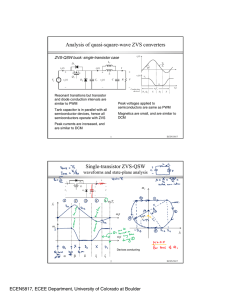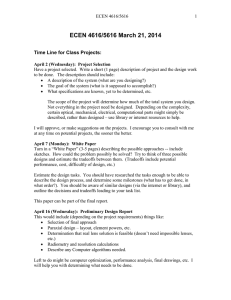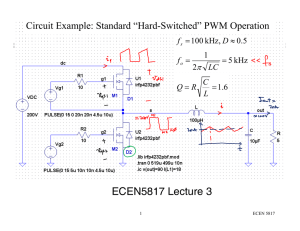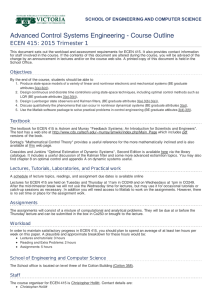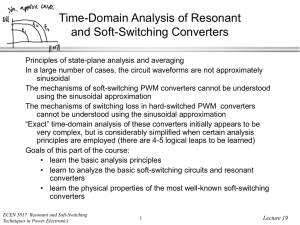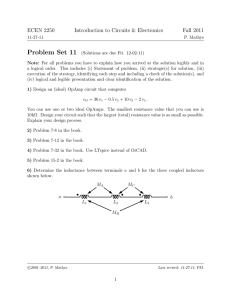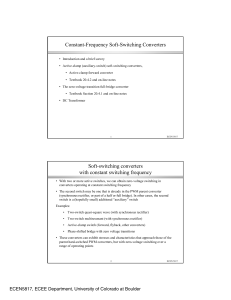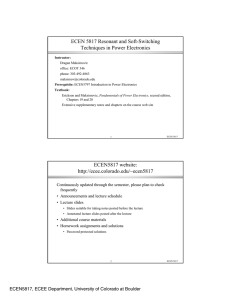ECEN 5817 Resonant and Soft-Switching Techniques
advertisement
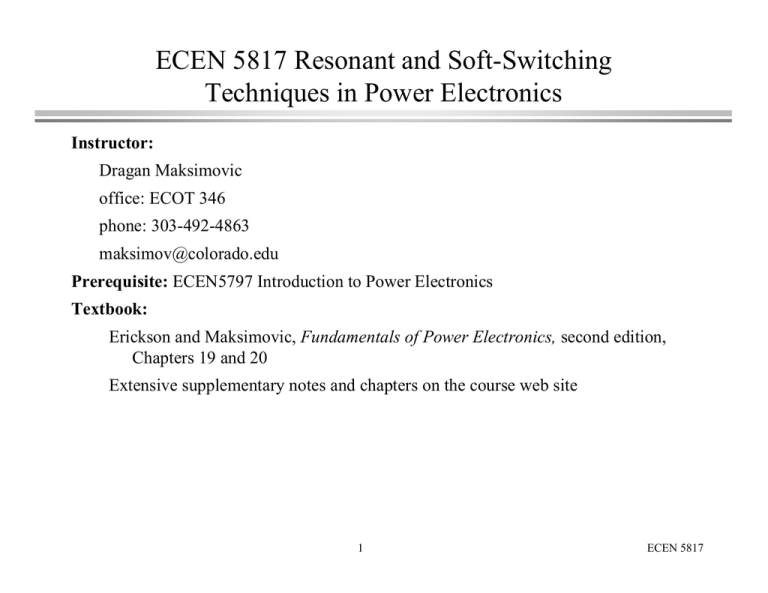
ECEN 5817 Resonant and Soft-Switching Techniques in Power Electronics Instructor: Dragan Maksimovic office: ECOT 346 phone: 303-492-4863 maksimov@colorado.edu Prerequisite: ECEN5797 Introduction to Power Electronics Textbook: Erickson E i k andd Maksimovic, M ki i Fundamentals F d t l off Power P Electronics, El t i secondd edition, diti Chapters 19 and 20 Extensive supplementary notes and chapters on the course web site 1 ECEN 5817 ECEN5817 website: http://ecee.colorado.edu/~ecen5817 Continuously updated through the semester, please plan to check frequently • Announcements and lecture schedule • Lecture slides • Slides suitable for taking notes posted before the lecture • Annotated lecture slides posted after the lecture • Additional course materials • Homework assignments and solutions • Password protected solutions 2 ECEN 5817 Preliminaries Assignments and exams • 10-12 week-long homework assignments posted on the course website • One midterm exam and one final exam, both take home Policies (see details on the course website) • Collaboration on HW assignment g is allowed • A blog has been setup to enable all students to exchange questions and comments on the course materials or homework problems; an invitation to contribute to the blog will be e-mailed this week • Copying someone else’s work is not allowed; all work you turn in must be your own • Absolutely no collaboration in any form allowed on the exams Grading • Homework (total) 40% • Midterm exam 20% • Final exam 40% 3 ECEN 5817 Notes for off-campus students • Send an e-mail to the instructor at maksimov@colorado.edu to introduce yourself and provide your preferred e-mail address on line by CAETE within 24 hours, often within hours • Lectures posted on-line • Due dates are nominally the same as for on-campus students, one week grace period allowed • To submit your work, scan (b&w, 150 dpi is fine) into a single easily readable pdf • Include your name and e-mail e mail address on the front page • Submit online via CU Boulder Desire2Learn (D2L) system • Alternative submission methods – Email the pdf as attachment to maksimov@colorado.edu maksimov@colorado edu – Fax to: 303-492-2758, addressed to Dragan Maksimovic, include ECEN5817, your name, hw#, and page number on every page – Mail to: Dragan Maksimovic ECEE Department 425 UCB University of Colorado Boulder, CO 80309-0425 • Keep a copy of your work 4 ECEN 5817 Office hours, questions Wednesday, 11 am -12pm, Thursday 9-10:30am MT Office: ECOT 346 Telephone: 303-492-4863 Blog or e-mail questions welcome at any time; will try to answer within 24 hours (M-F) Please use ECEN5817 in the subject line in any course-related emails 5 ECEN 5817 Introduction • Major power electronics applications: functionality, efficiency, size, cost • Power distribution systems, power supplies for wide range of applications • Energy-efficient lighting: electronic ballasts for fluorescent lamps, LED drivers • Hybrid and electric vehicles • Renewable energy systems: photovoltaic power systems, wind power systems • A simple converter example • Standard “hard-switching” operation • Resonant circuit basics • Switching losses • Soft-switching concept, introduction to zero-voltage switching (ZVS) converter operation • Introduction to resonant inverter operation • Advantages and disadvantages of resonant and soft-switching converters • Course outline 6 ECEN 5817 A Simple Converter Example • Synchronous buck point-of-load DC-DC converter • One leg of bridge DC-DC converters • One leg of single-phase or three-phase DC-AC inverters 7 ECEN 5817 Resonant Circuit Basics L vin + + – vout C 8 R _ ECEN 5817 Resonant Circuit: Frequency Response L vin i + + – vout C R _ 9 ECEN 5817 Resonant Circuit: Time Response L vin + + – vout C R _ 10 ECEN 5817 Circuit Example: Standard “Hard-Switched” PWM Operation f s 100 kHz, D 0.5 fo 1 2 LC QR 11 5 kHz C 1 .6 L ECEN 5817 L = 100 H, C = 10 F, R = 5 standard hard-switched PWM operation 12 ECEN 5817 Switching losses • Energy gy is lost duringg the semiconductor switchingg transitions, via several mechanisms: • Transistor switching times • Diode stored charge • Energy stored in device capacitances and parasitic inductances • Semiconductor devices are charge controlled – controlling lli charge h must be b inserted i d or removedd to switch a device 13 ECEN 5817 L = 100 H, C = 10 F, R = 5 : M1 turn-off, M2 turn on transition 14 ECEN 5817 M1 turn-off, M2 turn-on transition M1 + – VDC M2 D1 iL vs L Voutt D2 15 ECEN 5817
